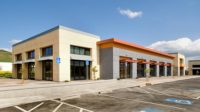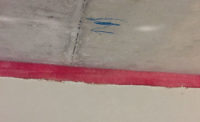The Evolution of Firestopping
A timeline of how far firestopping has come over the years.


Figure 1. 3M Fire Barrier Sealants.

Figure. 2 STI’s SpeedFlex Joint Profile.

Figure. 3 Combines with SpecSeal spray applied coatings to provide superior joint movement capabilities

Figure. 4 CEMCO FAS Track 1000 Deflection track with factory applied intumescent tape

Figure. 5 ClarkDietrich BlazeFrame deflection track with factory applied intumescent tape

FireWise diagram shows recommended locations and distances for where and how Firestop Joint Sealants and Sprays are to be destructively tested.

STI TTG Top Track Gasket.

3M Fire & Water, Smoke and Sound Tape.

CEMCO HOTROD Type X Compressible Firestopping Foam.

RECTORSEAL BLAZESEAL Firestop foam strips.

Hilti’s Top Track Seal (TTS) is a pre-formed firestop solution.

CEMCO HOTROD XL fire rated drywall accessory.

CEMCO FIRE BEAD fire rated drywall accessory.

CEMCO FIRE BEAD fire rated composite vinyl intumescent accessory.
Firestopping is the process of containing fire and/or smoke through the use of properly installed UL tested and certified products and assemblies. Firestopping, as we know it, has been around for approximately 40 years. This was kick started from the 1980 MGM Grand fire in which 85 people were killed (including seven employees) and 650 injured, including guests, employees, and 14 firefighters. Insurance companies were the driving force behind promoting and developing firestop products to minimize the risk of property lost. This created an increased demand for firestopping which ultimately lead to changes in the building codes.
At first, builders used what was readily available for firestopping. Drywall, mineral wool, steel framing, and spray-applied fireproofing were all products already known to restrict the passage of fire. Drywall manufacturers designed wall assemblies that could be tested per design standards found in ASTM E119 and ANSI/UL-263.
These original assemblies were great for restricting the passage of fire but did not do as well when it came to restricting the passage of smoke or aiding in protection in the event of seismic activity. Given that seventy-five people died from smoke inhalation and carbon monoxide poisoning in the MGM Grand fire, smoke seals became front and center and out of that came fire sealants and fire sprays (Figure 1). Fire sealants and fire sprays provided an improved flexible joint fill material and a superior smoke seal over the traditional methods of the time.
Although these earlier joint systems offered minimal dynamic movement, recent innovations have led to products such as STI’s SpeedFlex Joint Profile that combines with SpecSeal spray-applied coatings to provide superior joint movement capabilities in gypsum board construction (Figures 2 & 3).
Intumescent tracks
In 2008, factory applied intumescent tracks were introduced into the market. These composite products took intumescent tape that was previously used to provide a fire-rated seal to doors and added it to metal deflection tracks used in metal stud framing. These assemblies provided labor savings, a permanent seal, and high deflection movement (Figures 5 & 6).
Special Inspections
In 2012, a major code change was adopted into the 2012 International Building Code, “Special Inspections” for firestop penetrations and joints. Special inspections will require visual and or destructive testing. Destructive testing occurs when the special inspector will wait until the firestop product is fully cured and then take a “coupon” (removal of field installed firestop sealant or fire spray) of the sealant/spray to verify its depth at multiple locations at the bond lines. The bond line would be either at the penetration or the perimeter joint of the substrate interface. This code change was the result the firestopping industry wanted to ensure for proper installation of firestopping from qualified installers.
Preformed Fully Cured Firestopping
As with all major code changes, such as the 2012 IBC requirement for “Special Inspections” of firestop penetrations and joints, the firestopping manufacturers looked to develop products that could be easily inspected, easily installed, and reduce potential installation errors. In 2015, preformed/fully cured firestop products were introduced into the market. These products minimized installation error by providing products with factor metered dosage. Being fully cured products, they also provided easier and immediate inspections with no wait time. Today, nearly all the major firestop manufactures offer some type of preformed/fully cured firestopping for joints and penetrations (show in the figures on the following page).
Fire Rated Drywall Accessories
In 2019, Fire Rated Drywall Accessories were introduced into the market. These products combine intumescent tape with a flexible/paintable vinyl drywall accessory. The flexible vinyl profile provides an unbreakable seal against uneven concrete and roof decks while minimizing installation error. Since they are also fully cured, they also offer easier and immediate inspections with no wait time for curing (shown below and on the following page).
STC (Sound Transmission Class)
While firestopping is critical to modern construction, Sound Transmission Class (or STC) is quickly becoming equally important for overall “quality of life” in residential construction. STC is an integer rating of how well a building partition attenuates airborne sound. The higher the STC number, the better the sound protection.
With such an importance on STC ratings, modern day firestopping products will be expected to provide superior STC ratings. This means firestopping products will now have to undergo even more 3rd party testing for sound ratings. The AHJ (Authority Having Jurisdiction) should be mindful of this STC requirement as there are many different firestop products to choose from but they may not provide the suitable 3rd party sound testing reports.
Special Inspections
To best prepare for these special inspections and help your project have the most code compliant solution for the total life cycle of the structure, it has never been more imperative to properly select and install per tested listed systems as required in section 715 of the IBC. As product offerings continue to provide the contractor and design professional more options to meet today’s construction demands, there still are listed systems behind every installation needed for a project to meet your building code requirements and help reduce risk and liability for all parties involved. Additionally, the special inspector will be required to inspect any type of product used per ASTM E2393 and most likely will be required to perform a visual inspection during the time of installation for a preformed or precured firestopping joint product. These new product categories could help reduce some steps of inspection in certain Tested Listed Systems where mineral wool compression calculations or destructive samples of sealant depth may no longer be required.
To help limit delays on your project please remember to take all aspects of your design into the selection of these Tested Listed Systems and corresponding products, starting with your wall design, stud depths, designation of barriers (smoke barrier vs. fire barrier), building movement tolerances, STC values, etc. There are currently thousands of systems to select from, which is a huge improvement from the handful that were available in the early stages of the industry. But with that also comes confusion and assumptions that products hold the rating. Many websites, associations and companies are available to help aid you in the firestopping design process starting with the Firestop Manufacturer, Firestop Consultant and Firestop Specialty Contractor.
Fire and Life Safety
As the industry continues to grow and provide projects simpler yet faster materials to improve fire/smoke compartmentalization, it is imperative to remember that proper Firestop Design starts before any dirt is moved on a construction site. Being more proactive in your Firestop Design and selection of Firestopping Tested Listed Systems during preconstruction can not only help you reduce costs/delays during installation and inspection but also ensure your project is taking all of your buildings’ needs into consideration to meet building code requirements on this imperative and often misunderstood scope of Fire and Life Safety.
There are available resources such as the International Firestop Counsel, which is a nonprofit association of manufacturers, distributors, installers, inspectors and other key stakeholders interested in passive fire protection materials and systems in North America and abroad. With over 3 decades of members’ experience and a constant stream of innovation, the IFC is the one-stop source of firestop expertise.
The IFC also provides impartial broad-based education, information, procedures regarding firestop system selection, performance, installation and inspection to the construction and code-enforcement communities. W&C
Looking for a reprint of this article?
From high-res PDFs to custom plaques, order your copy today!







